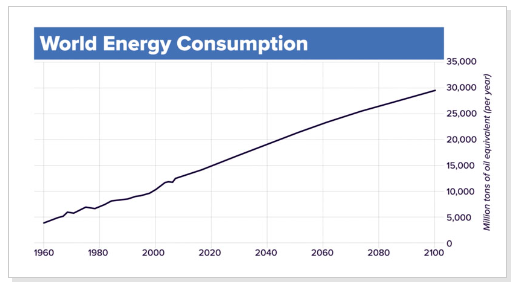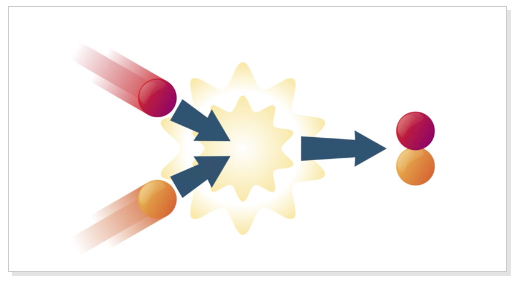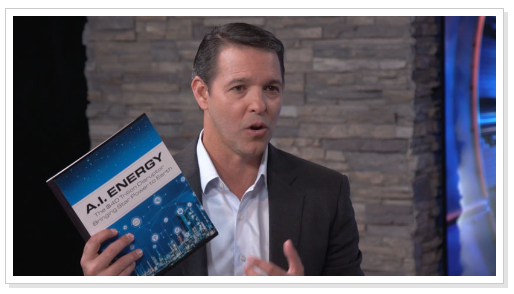Ian King says scientists and engineers at the renowned Lawrence Livermore National Laboratory in Silicon Valley have done the impossible and birthed a brand-new form of energy: “AI energy.”
It's a stunning breakthrough that could create $40 trillion in new wealth over the next decade.
The Teaser
Right now, there is no precedent for “AI energy”, but some experts believe it could be “even more important than the industrial revolution.”

Ian King calls himself a ‘futurist' for being at the bleeding edge of technological revolutions and covering the investment opportunities they produce. I have previously reviewed some of these opportunities here, including Ian's “Fourth Divergence” Microchip Stock and “Profit Framing” teasers.
One thing pretty much everyone can agree on is that we’re going to need a lot more in the future.
The demand curve on this is pretty cut and dry. More people, more houses, more cars = more energy.

At this moment, there are six major energy sources in the world:
- Oil (obviously)
- Coal
- Natural Gas
- Renewables
- Hydroelectric
- And Nuclear
What Ian is saying is that AI energy could single-handedly replace them all.
He doubles down on this, specifically intimating that AI energy “will be the greatest wealth generator in the history of mankind.” Our man is walking on some very dangerous prognosticator ground right now.
What exactly is “AI Energy?”
At the heart of AI energy is individual hydrogen atoms, which are the most abundant resource on the planet.
The teaser describes it as “192 individual laser beams simultaneously concentrating their energy on a single target and striking it with 1,000 times the power of the entire U.S. power grid.”
This is the result of an AI-powered supercomputer forcing two atoms to collide together, fusing it into one. It looks a little something like this:

That’s what AI energy or Fusion energy is and just a one-liter water bottle worth of fused atoms is enough to generate as much power as 29,000 barrels of oil!

What I gather from this, besides terrible flashbacks to high school physics class is that this is no ordinary development.
So far, 50 countries and big corporations like Google, Microsoft, Chevron, BP, and ConocoPhillips have all invested hundreds of millions into fusion energy projects.
One company is developing so-called “AI Boosters” for the world's most powerful supercomputers and it could be the missing component that finally makes fusion energy a commercial reality.
The Pitch
Ian has compiled his findings on it in a new report called: AI Energy — The $40 Trillion Disruptor Bringing Star Power to Earth!

This report is only available to subscribers of Ian's Strategic Fortunes investment newsletter. Like most newsletters in the current economy, it has slashed its price from $199 per year to just $49.
Included in this “special offer” are three reports, a monthly newsletter, a model portfolio, trade alerts via email, text, and through their app, as well as weekly livestreams covering important developments.
Unlimited, Clean, and Cheap Energy?
What held AI energy back until very recently were two significant roadblocks.
Didn't think it would be as easy as two microscopic atoms being fused into one and boom, all of our energy needs are met, did you?
The first roadblock was that we simply did not have the technology capable of handling the mathematical computations necessary to create such a fusion.
We now have supercomputers that are run by artificial intelligence, so that roadblock has been cleared.
The second roadblock was solving the same puzzle that needed to be solved when man first discovered fire – containment.
See, fusing atoms requires competing magnetic forces that push against each other. Ridiculously, powerful magnets.
The same AI-powered supercomputer that controls 192 lasers is also controlling a series of incredibly, strong, perfectly calibrated magnets.
These magnets act like a bunch of “poles” like our north and south pole. It’s called magnetic confinement, using magnetic fields to trap and control the fusion fuel in the form of a plasma.

Seriously complex stuff, no wonder it took 60 years to figure out, sheesh.
In the background of this breakthrough, is an innovative company developing a technology that takes the computational power of artificial intelligence to exponentially greater levels.
AI Boosters
This company is headquartered just down the road from the Lawrence Livermore National Laboratory where fusion energy was born, and this firm has invented tech that makes regular computers truly super.
Ian calls them “AI Boosters”, which in reality is Extreme Performance Yield Computing.
Imagine if you could insert a device into your car and make it 2 million times more powerful. It would make it a rocket ship!
Now imagine boosting the already incomprehensible performance of a supercomputer by 2 million times.
We're talking about the fastest supercomputer in the world that will help bring limitless, clean, and cheap fusion energy to the world, all thanks to this AI booster tech. Let's find out the name of the company behind it.
Revealing Ian King's AI Booster Company
Ian serves up several generic clues about this company:
- The firm holds 11,000 patents and their tech has become mission critical for the biggest fusion energy projects.
- Its shares currently trade for around $5.
- It has an innovative team of engineers who have worked at firms like Hewlett-Packard, IBM, and Micron to name a few.
Not much to go on, but it sounds to me like Ian's pick is very likely Xperi Inc. (NYSE: XPER). Here is why:
- It holds a portfolio of 11,000 patents in the media and semiconductor segments.
- Xperi shares currently trade at around $10. Not a perfect match, but not far off either.
- Several of the company's staff engineers are ex-IBM and Micron alumni.
100,000% Growth in Play?
Ian says 100,000% growth is in play or in other words, generational wealth when fusion energy makes its much-anticipated debut.
Is this posturing or does he have a legitimate case?
Forbes estimates fusion technology could be a $40 trillion market. The key word here is “could.”
The reality is, as the same Forbes article points out, commercial fusion is still years, if not decades away. This would explain why there aren't any pure-play public fusion energy companies.
Companies such as Chevron, GE, and Xperi all have exposure to the industry and will benefit to one degree or another if fusion does eventually pop off.
Xperi specifically is more of an entertainment technology company than anything else, deriving its revenue from smart TV and in-vehicle entertainment systems. Where the fusion energy angle comes in, is with its Perceive technology subsidiary, which was incubated in 2018 and makes AI processors and a full suite of development tools for integration into power‑constrained edge devices.
Its patented tech would apply to fusion reactors, but this is a way off as mentioned.
If you have a long timeline as an investor (years and decades), then it makes sense to delve deeper into the fusion energy space. If not, then it is simply not worth it, as that 100,000% growth isn't going to happen anytime soon, if ever.
Quick Recap & Conclusion
- Ian King is teasing a brand-new form of energy called “AI energy” and says it could create $40 trillion in new wealth over the next decade.
- What Ian calls “AI energy” is actually fusion energy, which holds out the promise of limitless, clean, and cheap energy and one company makes the “AI booster” technology that will make it a reality.
- The name and ticker symbol of this company are revealed in a new report called: AI Energy — The $40 Trillion Disruptor Bringing Star Power to Earth! This report is only available to subscribers of Ian's Strategic Fortunes investment newsletter, which is available at a discounted price of $49 for the first year.
- Not many clues were provided, and the ones we did get were generic, but Ian's pick here is likely Xperi Inc. (NYSE: XPER).
- Fusion energy is still years or perhaps decades away from powering our homes. Stocks like Xperi, Chevron, and GE, among others, do have exposure to the industry but don't expect huge gains to materialize anytime soon.
Will fusion energy ever become a commercial reality? Let us know what you think in the comments.

